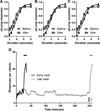Prospective memory: a comparative perspective
- PMID: 25101562
- PMCID: PMC4314352
- DOI: 10.1016/j.beproc.2014.07.016
Prospective memory: a comparative perspective
Abstract
Prospective memory consists of forming a representation of a future action, temporarily storing that representation in memory, and retrieving it at a future time point. Here, we review the recent development of animal models of prospective memory. We review experiments using rats that focus on the development of time-based and event-based prospective memory. Next, we review a number of prospective-memory approaches that have been used with a variety of non-human primates. Finally, we review selected approaches from the human literature on prospective memory to identify targets for development of animal models of prospective memory. This article is part of a Special Issue entitled: "Tribute to Tom Zentall".
Keywords: Animal models; Event-based prospective memory; Primate; Prospective memory; Rodent; Time-based prospective memory.
Copyright © 2014 Elsevier B.V. All rights reserved.
Figures




References
-
- Altgassen M, Koch A, Kliegel M. Do Inhibitory Control Demands Affect Event-Based Prospective Memory Performance in ADHD? Journal of attention disorders: 1087054713518236. 2014 - PubMed
-
- Atance CM, O'Neill DK. Episodic future thinking. Trends in cognitive sciences. 2001;5:533–539. - PubMed
-
- Beal CR. Memory for future intentions: Investigating pulses and steps. In: Gruneberg MM, Morris PE, Skyes RN, editors. Practical aspects of memory: Current research and issues. Chichester, UK: Wiley; 1987.
Publication types
MeSH terms
Grants and funding
LinkOut - more resources
Full Text Sources
Other Literature Sources
Medical

